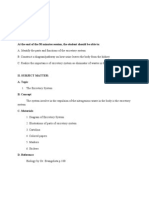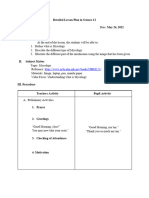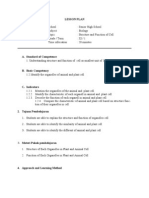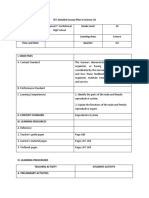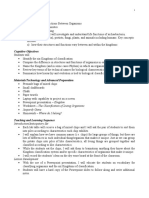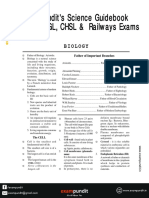Detailed Lesson in BIOLOGY
Uploaded by
Jamie anne HernandezDetailed Lesson in BIOLOGY
Uploaded by
Jamie anne HernandezDetailed Lesson Plan in Biology
I. Objectives
At the end of a 60-min period, at least 75% of the students will be able to:
A. Differentiate the animal and Plant Cell
B. Determine the parts of a plant and animal cell
C. Understand the functions of each part of the cell
II. Subject Matter
Animal and Plant Cell
Reference: Genetics and Molecular Biology Schleif, Robert (2001)
2nd edition, page 2-5
Materials: Charts, Book, Manila Paper, Pen, activity sheetValues: Creativity, Patience, Following
Instructions
III. Procedure
A. Learning Activities
TEACHER ACTIVITY STUDENT ACTIVITY
a.(Prayer, Greetings)
“Good Morning Class...”
"Good Morning Ma’am/Sir!”
“Let us pray first...”
The teacher will select who will lead the (One Student will lead the Prayer)
prayer
B.(Checking of Attendance)
say present...
The teacher will call the names of every
student. (Students will raise their hand and saypresent as
the teacher calls their name)
“Please keep all unnecessary things on your table” (Students will keep their things that nothing to do
with the lesson)
“So how’s your weekend?
It was great mam!”
“That’s good to hear! Did you enjoy it?”
“Of course mam! It was a lot of fun!”
c. (Review)
“Last time we discussed about
microscope, Right?”
“Yes Mam!”
“So before we proceed to our next lesson, Who
can give the different types of microscope? (At least one or two students will give hisor her
answer about the question.)
d. (Lesson Proper)
The teacher will give first the introduction
about the topic thendiscuss all necessary (The students will listen carefully to thediscussion
things tothat have something to do with and will interact with the teacher by sharing their
the lesson.“ knowledge about the topic.)
"Plant and animal cells have a greatdeal of The students will look at the side by side diagrams
similarities between them. The smaller of plant and animal cells.
components inside the cells, called organelles,
perform the same functions in each kind of cell.”
e. (Generalization)
“So what have you learned about cell?”
(At last 25% of the students will givetheir
understanding about the lesson.)
IV. Evaluation
In 1 whole sheet of manila paper the students will find their respective groups and makea Venn
diagram in order to determine the differences and similarities of the animal andplant cell.
After the activity the students will answer the activity sheet wherein they need to labelthe parts
of the cell and states its function.
V. Assignment
“Make a cell model using improvise materials”.
You might also like
- Science Classification of Animals Lesson Plan 4 14No ratings yetScience Classification of Animals Lesson Plan 4 148 pages
- Semi-Detailed LP Earth's Resources For Demo Teaching in PCHS - FinalNo ratings yetSemi-Detailed LP Earth's Resources For Demo Teaching in PCHS - Final5 pages
- Ukanteach 2 Lesson Plan: Title of Lesson: The Amazing Respiratory SystemNo ratings yetUkanteach 2 Lesson Plan: Title of Lesson: The Amazing Respiratory System16 pages
- DETAILED LESSON PLAN IN SCIENCE. Digestive Systemdocx100% (1)DETAILED LESSON PLAN IN SCIENCE. Digestive Systemdocx10 pages
- Detailed Lesson Plan in Science 7 Biodiversity The Learners Will Be Able ToNo ratings yetDetailed Lesson Plan in Science 7 Biodiversity The Learners Will Be Able To7 pages
- Designing Effective Scientific PresentationsNo ratings yetDesigning Effective Scientific Presentations36 pages
- Biology  - Chapter 16 Assessment Answers1No ratings yetBiology  - Chapter 16 Assessment Answers13 pages
- How The Bio Revolution Could Transform The Competitive LandscapeNo ratings yetHow The Bio Revolution Could Transform The Competitive Landscape10 pages
- Native Afforestation A Literature Review On Best Nursery Practices and Traceability Systems in Native Seedling ProductionNo ratings yetNative Afforestation A Literature Review On Best Nursery Practices and Traceability Systems in Native Seedling Production38 pages
- Roles of a Biochemist at Nnpc - Google SearchNo ratings yetRoles of a Biochemist at Nnpc - Google Search7 pages
- Science Guidebook For SSC CGL, CHSL, Railways & PSC Exams - Exampundit - in PDFNo ratings yetScience Guidebook For SSC CGL, CHSL, Railways & PSC Exams - Exampundit - in PDF55 pages
- Problems and Prospects of Genetically Modified Organisms in Agricultural ProductionNo ratings yetProblems and Prospects of Genetically Modified Organisms in Agricultural Production36 pages
- Https App.oswaalbooks.com Download Sample-qp Subsolution 606Science SAP-4 Sol (1)No ratings yetHttps App.oswaalbooks.com Download Sample-qp Subsolution 606Science SAP-4 Sol (1)6 pages
- Anthropology by Haviland, Prins, Walrath & McBride PDF100% (1)Anthropology by Haviland, Prins, Walrath & McBride PDF745 pages
- 7828 Dpsy535 Biological Basis of BehaviourNo ratings yet7828 Dpsy535 Biological Basis of Behaviour110 pages
- NIST Traceable Polystyrene Particle Size StandardsNo ratings yetNIST Traceable Polystyrene Particle Size Standards2 pages
- Biobank Doggo - Purpose - Partnership - and - Possibilities - The - ImplemenNo ratings yetBiobank Doggo - Purpose - Partnership - and - Possibilities - The - Implemen11 pages


